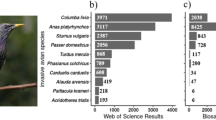Abstract
We examine how interspecific competition and two types of size-selective predation affect population density, variability and persistence in laboratory cultures of two species of Daphnia, D. magna and D. longispina. When both species were analysed together, and for D. longispina alone, there were weak negative relationships between mean population density and population variability. Interspecific competition resulted in lower population densities and higher population variability. Extinct populations had lower densities and were also more variable than persisting ones. There was still an effect of population variability on extinction probability after the effect of density on population variability had been accounted for. Hence, the effects of population density and variability on population persistence were partly independent of each other. The effects of size-selective predation on population persistence were more species-specific and not directly related to density or variability. Since the effects of species interactions on persistence were large, we suggest that it is likely that population vulnerability analyses not incorporating effects of interspecific interactions are often misleading.
Similar content being viewed by others
References
Anderson RM, Gordon DM, Crawley MJ, Hassell MP (1982) Variability in the abundance of animal and plant species. Nature 296: 245–247
Ås S, Bengtsson J, Ebenhard T (1992) Archipelagoes and theories of insularity. In: Hansson L (ed) Ecological principles of nature conservation. Elsevier, London, pp 201–251
Bengtsson J (1986) Life histories and interspecific competition between three Daphnia species in rockpools. J Anim Ecol 55: 641–655
Bengtsson J (1987) Competitive dominance among Cladocera: are single-factor explanations enough? Hydrobiologia 145: 245–257
Bengtsson J (1989) Interspecific competition increases extinction rate in a metapopulation system. Nature 340: 713–715
Bengtsson J (1993) Interspecific competition and determinants of extinction in experimental populations of three Daphnia species. Oikos 67: 451–464
Bengtsson J, Fagerström T, Rydin H (1994) Competition and co-existence in plant communities. Trends Ecol Evol 9: 246–250
Crawley MJ (1992) Natural enemies. Blackwell, Oxford
Forney KA, Gilpin KE (1989) Spatial structure and population extinction: a study with Drosophila flies. Conserv Biol 3: 45–51
Gaston KJ, McArdle BH (1993) Measurement of variation in the size of populations in space and time: some points of clarification. Oikos 68: 357–360
Hanski I, Woiwod IP (1993) Mean-related stochasticity and population variability. Oikos 67: 29–39
Hansson L (1987) An interpretation of rodent dynamics as due to trophic interactions. Oikos 50: 308–318
Holt RD, Lawton JH (1993) Apparent competition and enemy-free space in insect host-parasitoid communities. Am Nat 142: 623–645
Karr JR (1982) Population variability and extinction in the avifauna of a tropical landbridge island. Ecology 63: 1975–1978
Lawler S (1993) Species richness, species composition and population dynamics of protists in experimental microcosms. J Anim Ecol 62: 711–719
Leps J (1993) Taylor's power law and the measurement of variation in the size of populations in space and time. Oikos 68: 349–356
MacArthur RH, Wilson EO (1967) The theory of island biogeography. Princeton University Press, Princeton
Matveev V (1983) Estimating competition in Cladocerans using data on dynamics of clutch size and population density. Int Rev Ges Hydrobiol 68: 785–798
May RM (1973) Stability and complexity in model ecosystems. Princeton University Press, Princeton
May RM, Watts CH (1992) The dynamics of predator-prey and resource-harvester systems. In: Crawley MJ (ed) Natural enemies. Blackwell, Oxford, pp 431–457
McArdle BH, Gaston KJ (1992) Comparing population variabilities. Oikos 64: 610–612
McArdle BH, Gaston KJ (1993) The temporal variability of populations. Oikos 67: 187–191
McArdle BH, Gaston KJ, Lawton JH (1990) Variation in the size of animal populations: Patterns, problems and artefacts. J Anim Ecol 59: 439–454
McCauley E, Murdoch WW (1987) Cyclic and stable populations: plankton as paradigm. Am Nat 129: 97–121
Milbrink G, Bengtsson J (1991) The impact of size-selective predation on competition between two Daphnia species: a laboratory study. J Anim Ecol 60: 1009–1028
Morin P, Lawler S (in press) Effects of food chain length and omnivory on population dynamics in experimental food webs. In: Polis G, Winemiller K (eds) Food webs: patterns and processes. Chapman and Hall, New York
Moulton MP, Pimm SL (1986) The extent of competition in shaping an introduced avifauna. In: Diamond J, Case TJ (eds) Community ecology. Harper and Row, New York, pp 80–97
Pimm SL (1991) The balance of nature: ecological issues in the conservation of species and communities. The University of Chicago Press, Chicago
Pimm SL, Redfearn A (1988) The variability of population densities. Nature 334: 613–614
Pimm SL, Jones HL, Diamond J (1988) On the risk of extinction. Am Nat 132: 757–785
Ranta E (1979) Niche of Daphnia species in rock pools. Arch Hydrobiol 87: 205–223
Redfearn A, Pimm SL (1992) Natural enemies and community dynamics. In: Crawley MJ (ed) Natural enemies. Blackwell, Oxford, pp 395–411
Schoener TW, Spiller DA (1987) High population persistence in a system with high turnover. Nature 330: 474–477
Schoener TW, Spiller DA (1992) Is extinction rate related to temporal variability in population size? An empirical answer for orb spiders. Am Nat 139: 1176–1207
Simberloff D, Boecklen W (1991) Patterns of extinction in the introduced Hawaiian avifauna: a reexamination of the role of competition. Am Nat 138: 300–327
Taylor LR, Woiwod IP (1980) Temporal stability as a density-dependent species characteristic. J Anim Ecol 49: 209–224
Tracy CR, George TL (1992) On the determinants of extinction. Am Nat 139: 102–122
Williamson MH (1972) The analysis of biological populations. Arnold, London
Williamson MH (1983) Variations in population density and extinction. Nature 303: 201
Wright SJ, Hubbell SP (1983) Stochastic extinction and reserve size: a focal species approach. Oikos 41: 466–476
Zaret TM (1980) Predation and freshwater communities. Yale University Press, New Haven
Author information
Authors and Affiliations
Rights and permissions
About this article
Cite this article
Bengtsson, J., Milbrink, G. Predicting extinctions: interspecific competition, predation and population variability in experimental Daphnia populations. Oecologia 101, 397–406 (1995). https://doi.org/10.1007/BF00329418
Received:
Accepted:
Issue Date:
DOI: https://doi.org/10.1007/BF00329418




